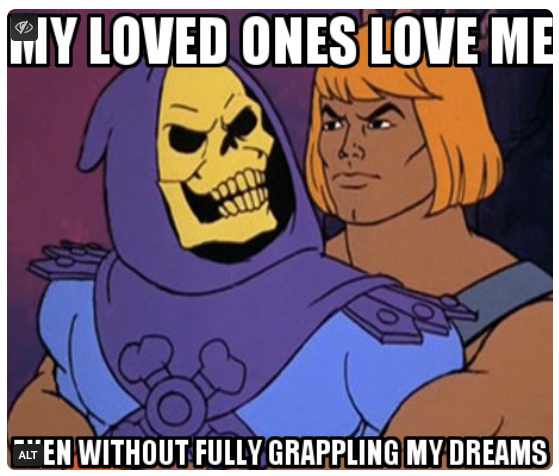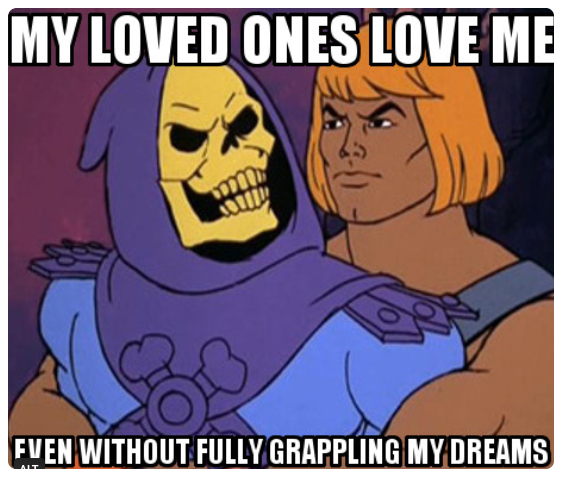Removing a div with Greasemonkey
To get rid of minor annoyances in your favorite websites, you can use Greasemonkey to tweak html where needed. Thehide image and ALT buttons on Mastodon images
are such an annoyance - I rarely need these buttons, but they do interfere with images.
Text in images may become unreadable, like in the messages from
inspirational Skeletor:

greasemonkey
Greasemonkey is an add-on for Firefox that allows a user to add custom behaviour to pages by creating scripts that run on page load and can modify the html, css or javascript on a page. For Chrome Tampermonkey will do the same. To get Greasemonkey running, get it here and restart your browser. You will now see a little monkey head in the top right corner of your browser. You can install the script below by opening this link to the script in your browser. Alternatively you can click the monkey's head and chooseNew user script.... Fill out the required fields and then paste the
script content below in the edit window (by default pasting is disabled in the editor,
so you may have to enable this first).
The Greasemonkey script that will hide the buttons:
// ==UserScript==
// @name Mastodon Image Liberator
// @namespace janjongerden.nl
// @version 1.0
// @description Hide the buttons on top of images
// @author Jan Jongerden
// @include https://mas.to/*
// @grant none
// ==/UserScript==
const cleanButtons = () => {
const hideButtons = document.querySelectorAll('.media-gallery__actions__pill');
hideButtons.forEach(element => {
element.style.display = 'none';
});
const altButtons = document.querySelectorAll('.media-gallery__item__badges');
altButtons.forEach(element => {
element.style.bottom = '-9px';
});
};
var repeater = setInterval(cleanButtons, 1000);
https://mas.to/ and
hides the buttons. The hide image button is removed completely and
the ALT button is only pushed down a bit, as I do find it useful occasionally.
The procedure is repeated every second, as new images are loaded on the fly as you
scroll down your message feed.
Of all Greasemonkey annotations in the header, the most interesting part is the
@include, which states on which pages the script should run. If your home
is a different Mastodon instance, you should adjust this accordingly. You can check
the API reference to learn
more about the other tags. The syntax of the body of the user script is just plain javascript.
When installed, the image is cleaned up, and Skeletor's piece of wisdom can be enjoyed:

the mobile story
For mobile a slightly different approach is needed: the Greasemonkey add-on is not yet available for Firefox on Android as far as I can tell. However, there is an alternative extension, the Unified Script Injector (USI). Even though the extension claims to have only limited support for Greasemonkey scripts, it did the job for this simple script. Once you have installed the extension, you can add new user scripts by going to the FireFox menu, open Extensions -> USI, choose 'create new userscript' and paste the content of the user script. I'm sure similar solutions are available for other mobile browsers, but I haven't tried this myself.caveats
Greasemonkey scripts are inherently fragile as small changes in the target page could break your script. When a css class is renamed or the html structure is changed, you may have to update the logic in your script. Another issue is modifying elements that accidentally match your filter, like removing other buttons with the same css class, which could break the layout or functionality of the page.-
Open GitHub when pushing a new branch
A trick to quickly create a pull request when pushing a new branch to remote by opening the repo in your browser.
-
Fighting html form bots
A tale of fighting spam bots abusing my contact form. A series of experiments led to a simple solution to stop the bots.
-
How to include code in your web page
Short howto on presenting code snippets in an HTML page.